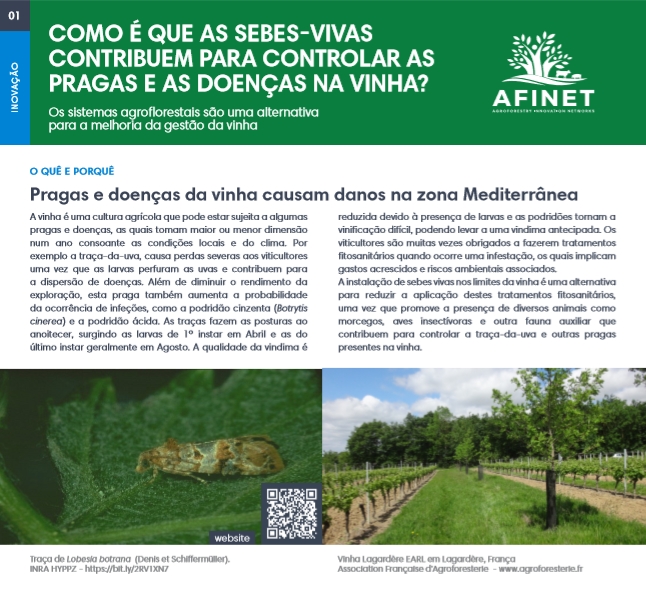 |
01 Como é que as sebes-vivas contribuem para controlar as pragas e as doenças na vinha? A vinha é uma cultura agrícola que pode estar sujeita a algumas pragas e doenças, as quais tomam maior ou menor dimensão num ano consoante as condições locais e do clima. Por exemplo a traça-da-uva, causa perdas severas aos viticultores uma vez que as larvas perfuram as uvas e contribuem para a dispersão de doenças. Além de diminuir o rendimento da exploração, esta praga também aumenta a probabilidade da ocorrência de infeções, como a podridão cinzenta ("Botrytis cinerea") e a podridão ácida. |
|
 |
Para muitos dos proprietários florestais privados na Finlândia (c.a 600 mil), a floresta é uma fonte de rendimento adicional. Por exemplo, o rendimento proveniente do abate de árvores de pequeno diâmetro, resultantes dos desbastes, é muito reduzido. A produção de cogumelos numa propriedade florestal pode aumentar o rendimento destes proprietários, obtendo-se um retorno financeiro entre 1 ano após a inoculação, ou até 8 anos após a inoculação no caso de cogumelos chaga (Inonotus obliquus). |
|
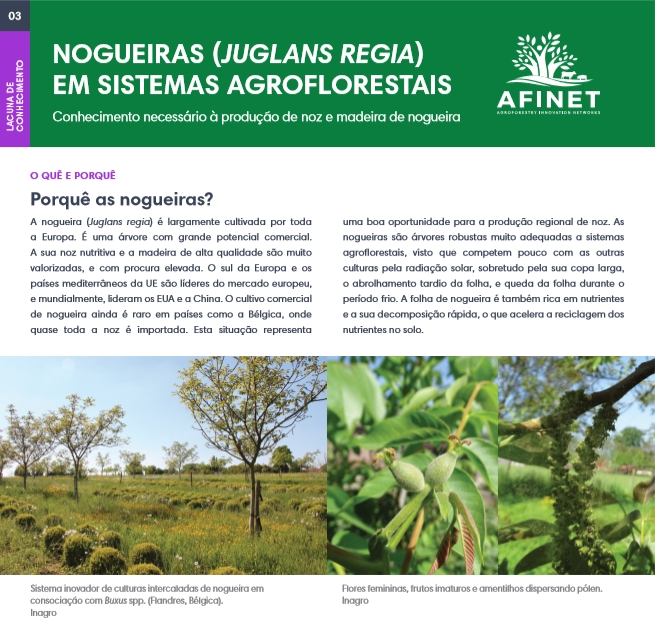 |
03 Nogueiras ("Juglans regia") em sistemas agroflorestais A nogueira ("Juglans regia") é largamente cultivada por toda a Europa. É uma árvore com grande potencial comercial. A sua noz nutritiva e a madeira de alta qualidade são muito valorizadas, e com procura elevada. O sul da Europa e os países mediterrâneos da UE são líderes do mercado europeu, e mundialmente, lideram os EUA e a China. O cultivo comercial de nogueira ainda é raro em países como a Bélgica, onde quase toda a noz é importada. |
|
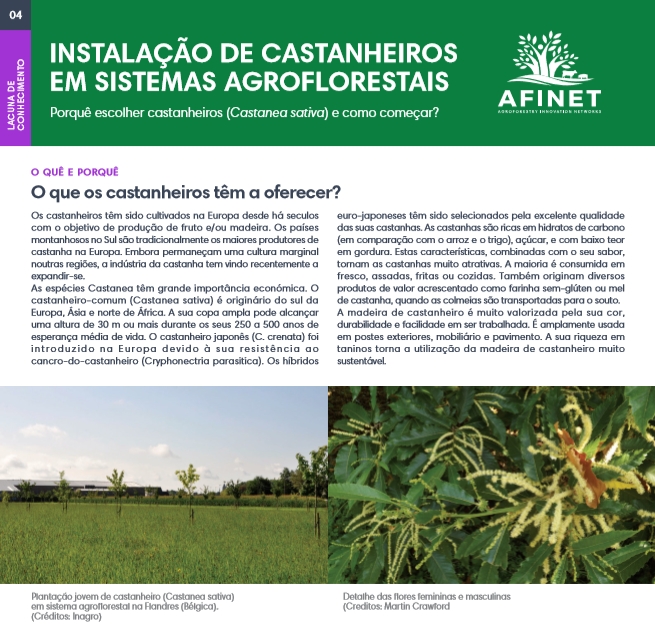 |
04 Instalação de castanheiros em sistemas agroflorestais Os castanheiros têm sido cultivados na Europa desde há seculos com o objetivo de produção de fruto e/ou madeira. Os países montanhosos no Sul são tradicionalmente os maiores produtores de castanha na Europa. Embora permaneçam uma cultura marginal noutras regiões, a indústria da castanha tem vindo recentemente a expandir-se. |
|
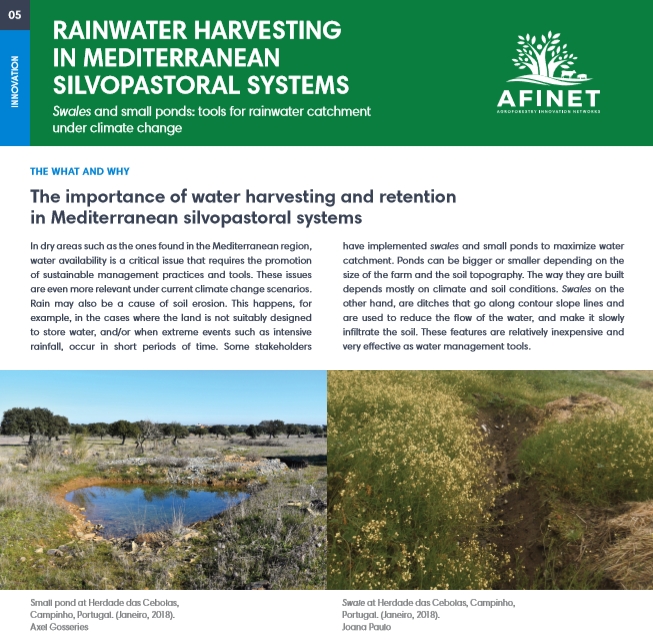 |
05 Captação de águas pluviais em sistemas silvopastoris no mediterrâneo Nas regiões secas, como na bacia Mediterrânica, a disponibilidade de água é uma preocupação que requer a promoção de práticas e ferramentas de gestão sustentáveis. Este problema é ainda mais acentuado num cenário de alterações climáticas. |
|
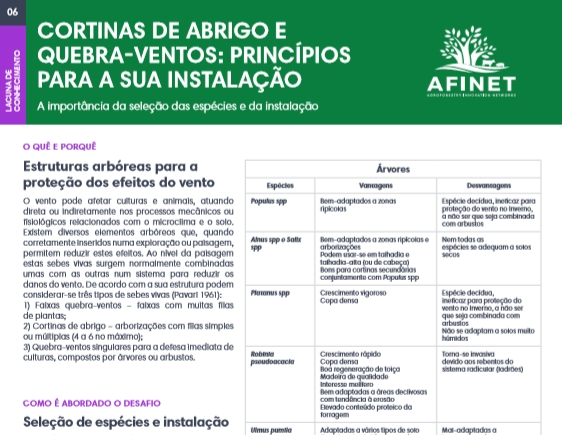 |
06 Cortinas de abrigo e quebra-ventos: princípios para a sua instalação O vento pode afetar culturas e animais, atuando dieta ou indiretamente nos processos mecânicos ou fisiológicos relacionados com o microclima e o solo. Existem diversos elementos arbóreos que, quando corretamente inseridos numa exploração ou paisagem, permitem reduzir estes efeitos. Ao nível da paisagem estas sebes vivas surgem normalmente combinadas umas com as outras num sistema para reduzir os danos do vento. |
|
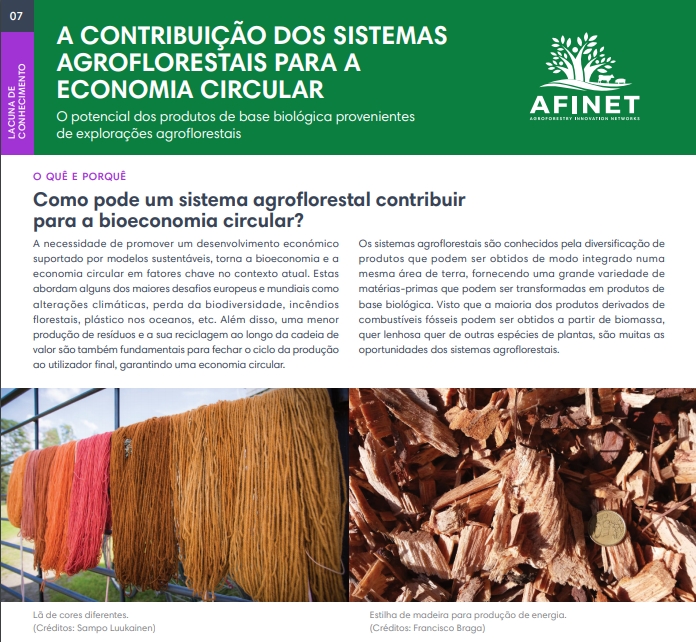 |
07 A contribuição dos sistemas agroflorestais para a economia circular A necessidade de promover um desenvolvimento económico suportado por modelos sustentáveis, torna a bioeconomia e a economia circular em fatores chave no contexto atual. Estas abordam alguns dos maiores desafios europeus e mundiais como alterações climáticas, perda da biodiversidade, incêndios florestais, plástico nos oceanos, etc. |
|
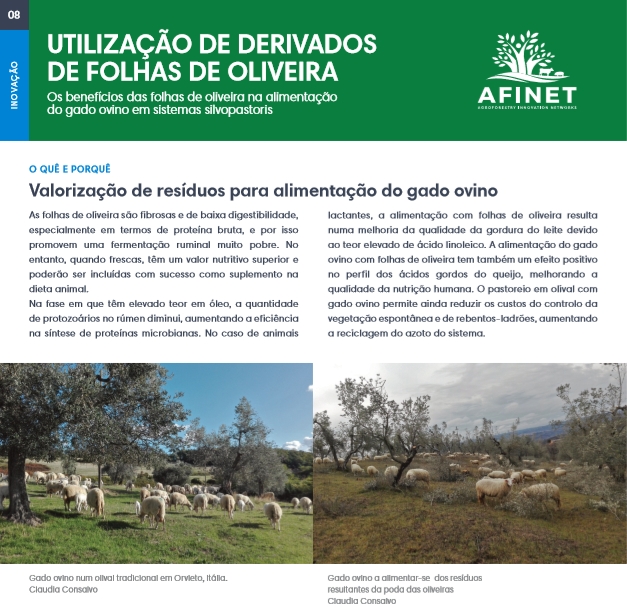 |
08 Utilização de derivados de folha de oliveira As folhas de oliveira são fibrosas e de baixa digestibilidade, especialmente em termos de proteína bruta, e por isso promovem uma fermentação ruminal muito pobre. No entanto, quando frescas, têm um valor nutritivo superior e poderão ser incluídas com sucesso como suplemento na dieta animal. |
|
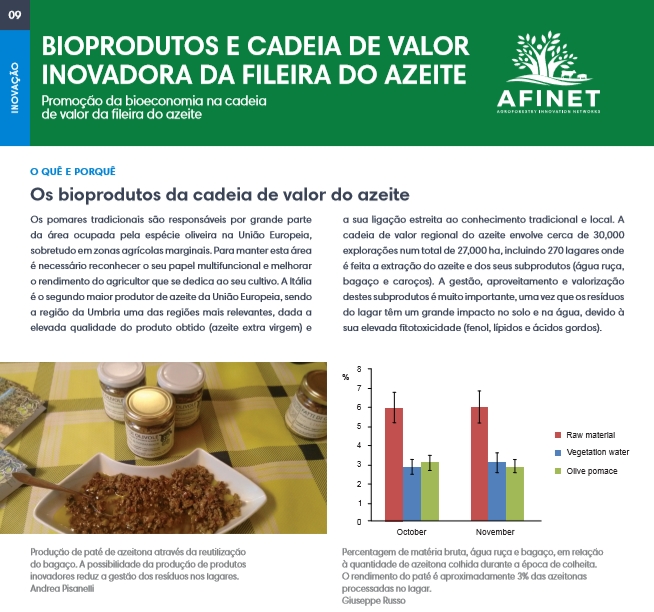 |
09 Bioprodutos e cadeia de valor inovadora da fileira do azeita Os pomares tradicionais são responsáveis por grande parte da área ocupada pela espécie oliveira na União Europeia, sobretudo em zonas agrícolas marginais. Para manter esta área é necessário reconhecer o seu papel multifuncional e melhorar o rendimento do agricultor que se dedica ao seu cultivo. |
|
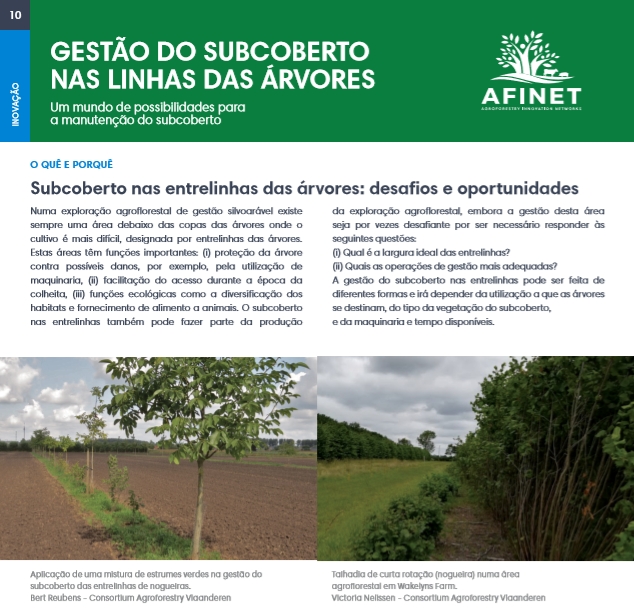 |
10 Gestão do subcoberto nas linhas das árvores Numa exploração agroflorestal de gestão silvoarável existe sempre uma área debaixo das copas das árvores onde o cultivo é mais difícil, designada por entrelinhas das árvores. Estas áreas têm funções importantes: (i) proteção da árvore contra possíveis danos, por exemplo, pela utilização de maquinaria, (ii) facilitação do acesso durante a época da colheita, (iii) funções ecológicas como a diversificação dos habitats e fornecimento de alimento a animais. |
|
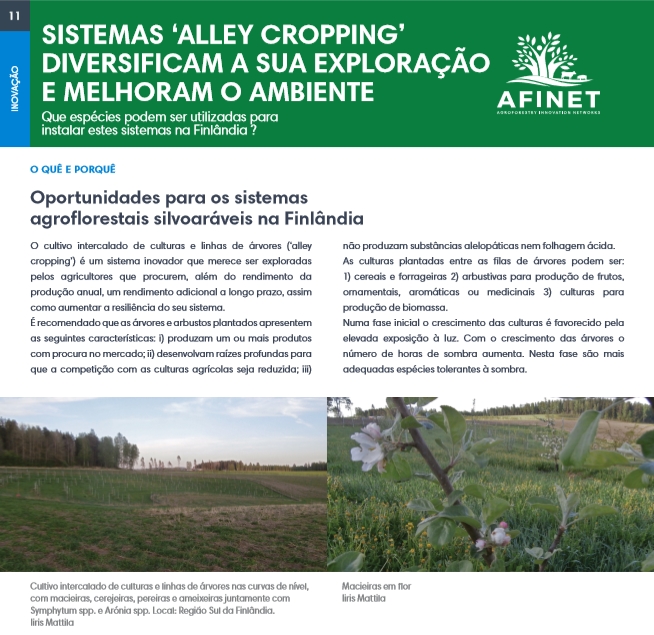 |
11 Sistemas 'alley cropping' diversificam a sua exploração e melhoram o ambiente O cultivo intercalado de culturas e linhas de árvores (‘alley cropping’) é um sistema inovador que merece ser exploradas pelos agricultores que procurem, além do rendimento da produção anual, um rendimento adicional a longo prazo, assim como aumentar a resiliência do seu sistema. |
|
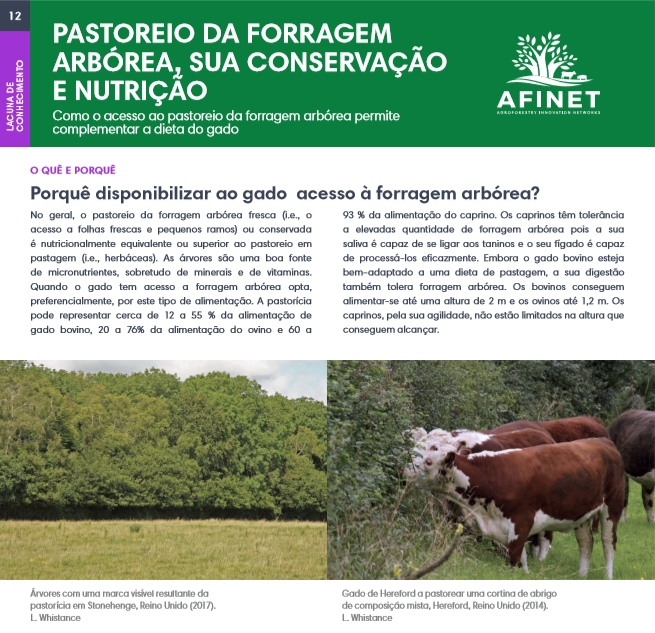 |
12 Pastoreio da forragem arbórea, sua conservação e nutrição No geral, o pastoreio da forragem arbórea fresca (i.e., o acesso a folhas frescas e pequenos ramos) ou conservada é nutricionalmente equivalente ou superior ao pastoreio em pastagem (i.e., herbáceas). As árvores são uma boa fonte de micronutrientes, sobretudo de minerais e de vitaminas. |
|
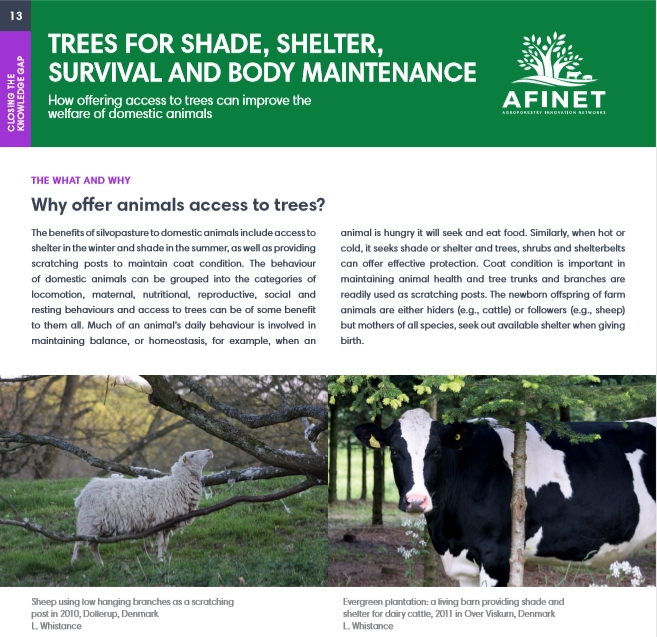 |
13 Trees for shade, shelter, survival and body maintenance The benefits of silvopasture to domestic animals include access to shelter in the winter and shade in the summer, as well as providing scratching posts to maintain coat condition. The behaviour of domestic animals can be grouped into the categories of locomotion, maternal, nutritional, reproductive, social and resting behaviours and access to trees can be of some benefit to them all. |
|
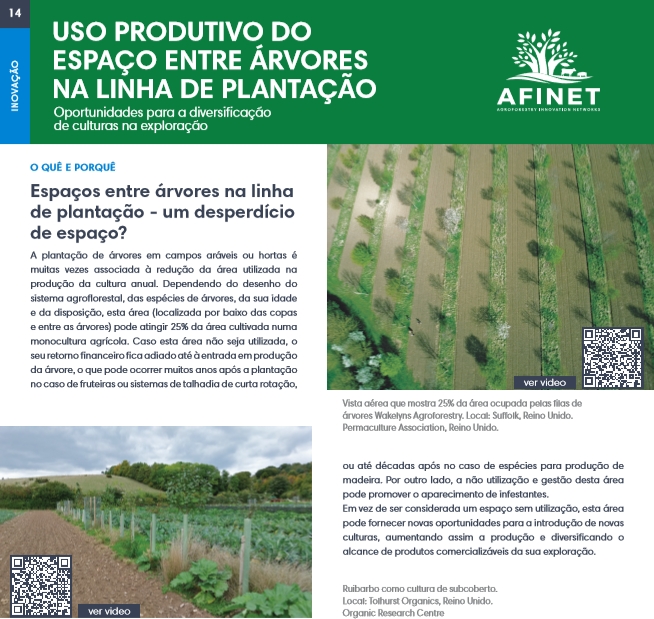 |
14 Uso produtivo do espaço entre árvores na linha de plantação A plantação de árvores em campos aráveis ou hortas é muitas vezes associada à redução da área utilizada na produção da cultura anual. Dependendo do desenho do sistema agroflorestal, das espécies de árvores, da sua idade e da disposição, esta área (localizada por baixo das copas e entre as árvores) pode atingir 25% da área cultivada numa monocultura agrícola. |
|
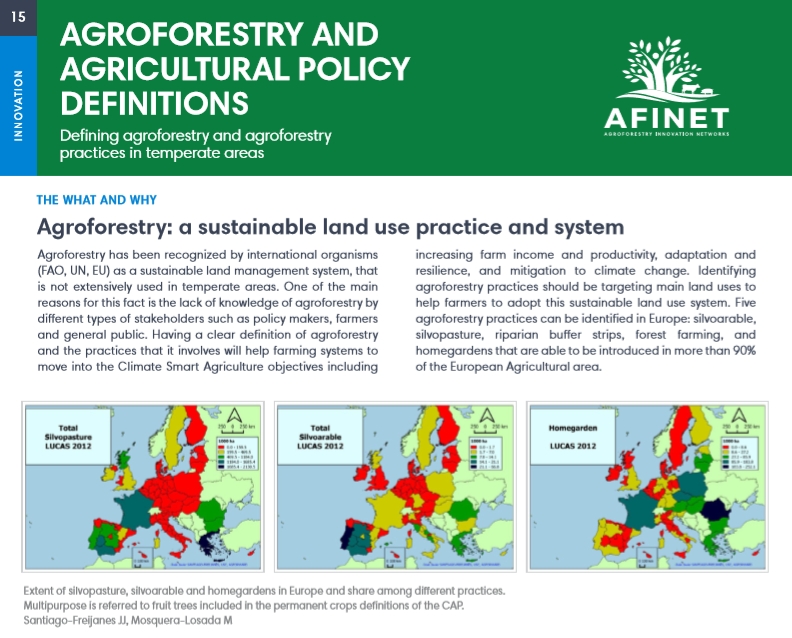 |
15 Agroforestry and agricultural policy definitions Agroforestry has been recognized by international organisms (FAO, UN, EU) as a sustainable land management system, that is not extensively used in temperate areas. One of the main reasons for this fact is the lack of knowledge of agroforestry by different types of stakeholders such as policy makers, farmers and general public. Download the high resolution print version (available soon) |
|
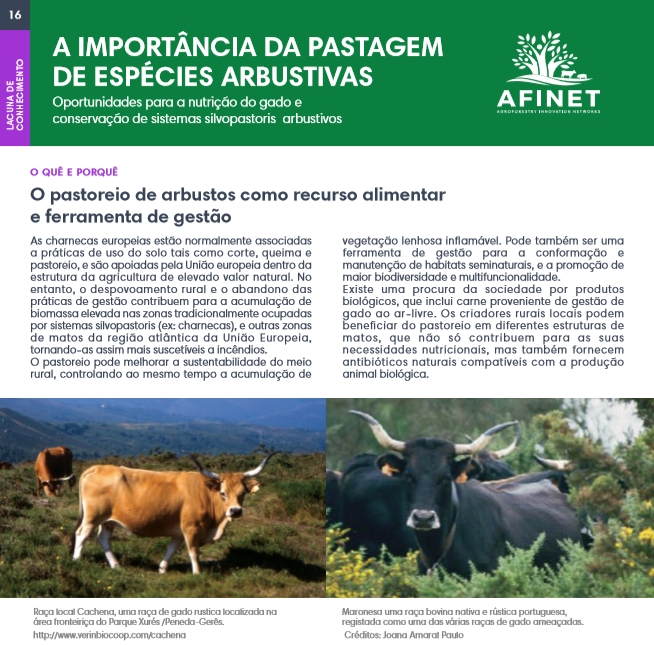 |
16 A importância da pastagem de espécies arbustivas As charnecas europeias estão normalmente associadas a práticas de uso do solo tais como corte, queima e pastoreio, e são apoiadas pela União Europeia dentro da estrutura da agricultura de elevado valor natural. No entanto, o despovoamento rural e o abandono das práticas de gestão contribuem para a acumulação de biomassa elevada nas zonas tradicionalmente ocupadas por sistemas silvopastoris (ex: charnecas), e outras zonas de matos da região atlântica da União Europeia, tornando-as assim mais suscetíveis a incêndios. |
|
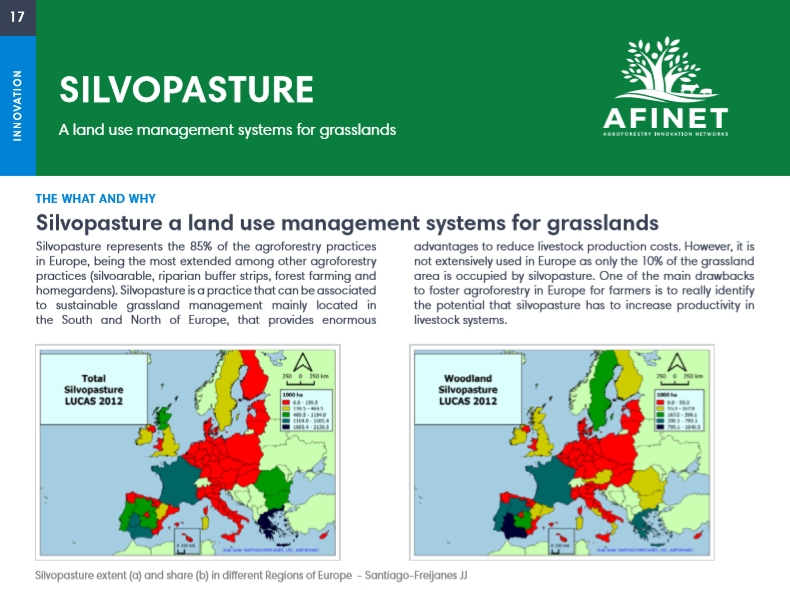 |
Silvopasture represents the 85% of the agroforestry practices in Europe, being the most extended among other agroforestry practices (silvoarable, riparian buffer strips, forest farming and homegardens). Silvopasture is a practice that can be associated to sustainable grassland management mainly located in the South and North of Europe, that provides enormous advantages to reduce livestock production costs. Download the high resolution print version (available soon) |
|
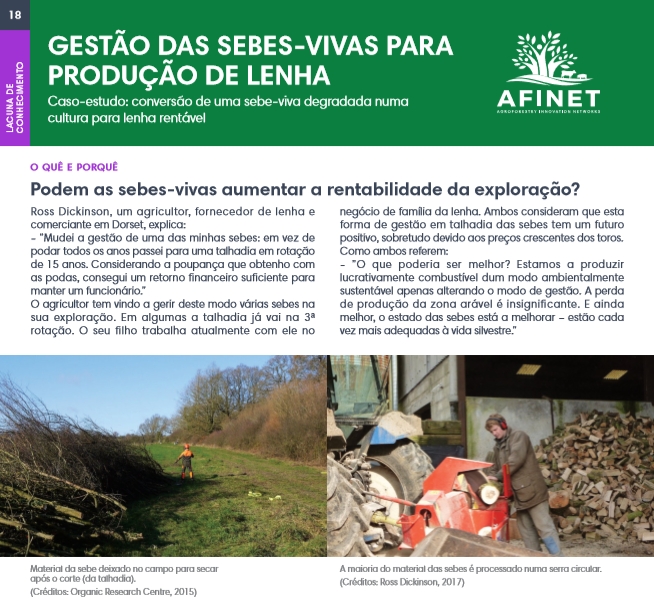 |
18 Gestão das sebes-vivas para produção de lenha Ross Dickinson, um agricultor, fornecedor de lenha e comerciante em Dorset, explica “Mudei a gestão de uma das minhas sebes: em vez de podar todos os anos passei para uma talhadia em rotação de 15 anos. Considerando a poupança que obtenho com as podas, consegui um retorno financeiro suficiente para manter um funcionário. |
|
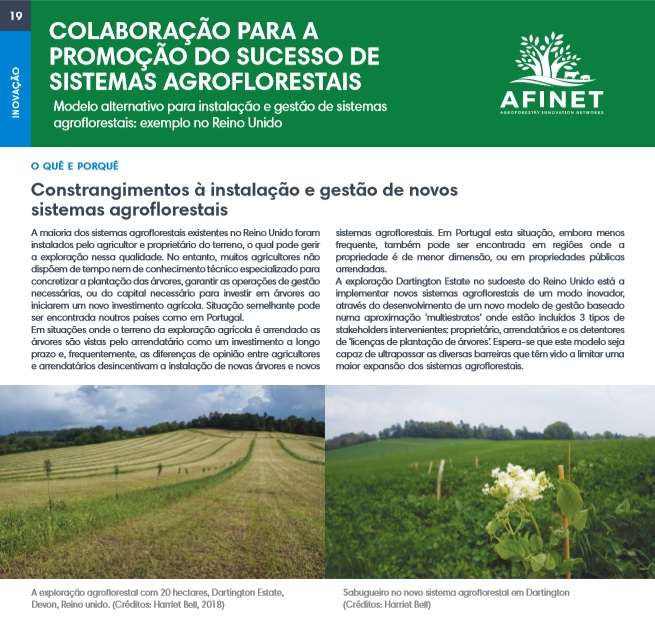 |
19 Colaboração para a promoção do sucesso de sistemas agroflorestais A maioria dos sistemas agroflorestais existentes no Reino Unido foram instalados pelo agricultor e proprietário do terreno, o qual pode gerir a exploração nessa qualidade. No entanto, muitos agricultores não dispõem de tempo nem de conhecimento técnico especializado para concretizar a plantação das árvores, garantir as operações de gestão necessárias, ou do capital necessário para investir em árvores ao iniciarem um novo investimento agrícola. Situação semelhante pode ser encontrada noutros países como em Portugal. |
|
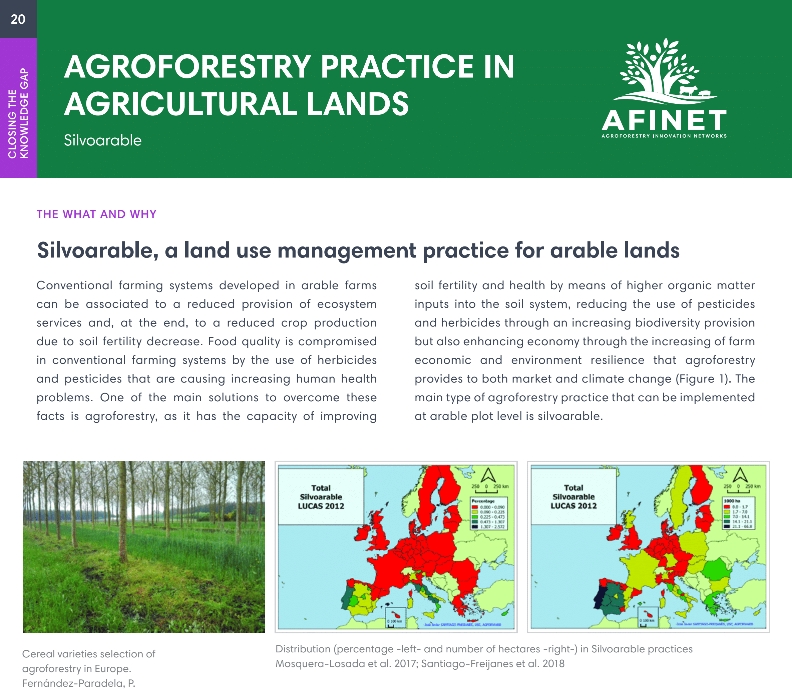 |
20 Agroforestry practice in agricultural lands Conventional farming systems developed in arable farms can be associated to a reduced provision of ecosystem services and, at the end, to a reduced crop production due to soil fertility decrease. Food quality is compromised in conventional farming systems by the use of herbicides and pesticides that are causing increasing human health problems. Download the high resolution print version (available soon) |
|
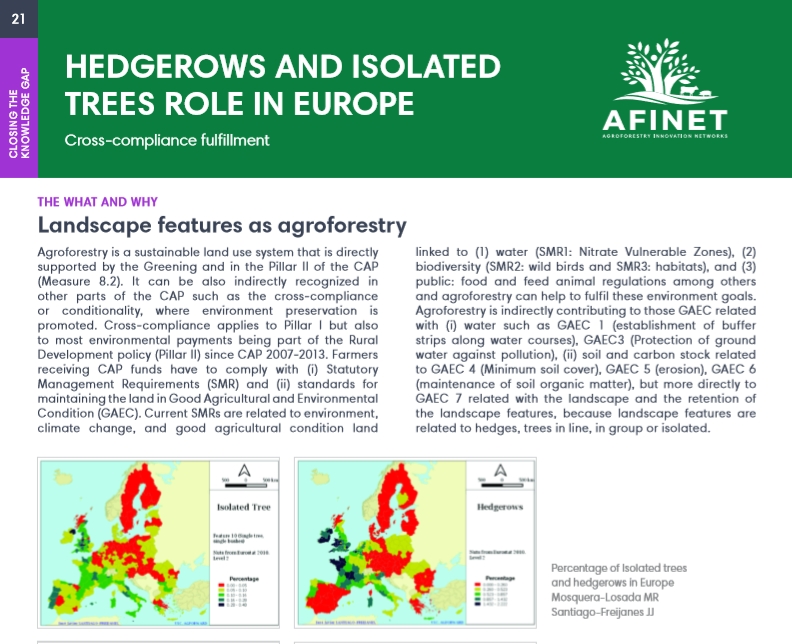 |
21 Hedgerows and isolated trees role in Europe Agroforestry is a sustainable land use system that is directly supported by the Greening and in the Pillar II of the CAP (Measure 8.2). It can be also indirectly recognized in other parts of the CAP such as the cross-compliance or conditionality, where environment preservation is promoted. Download the high resolution print version (available soon) |
|
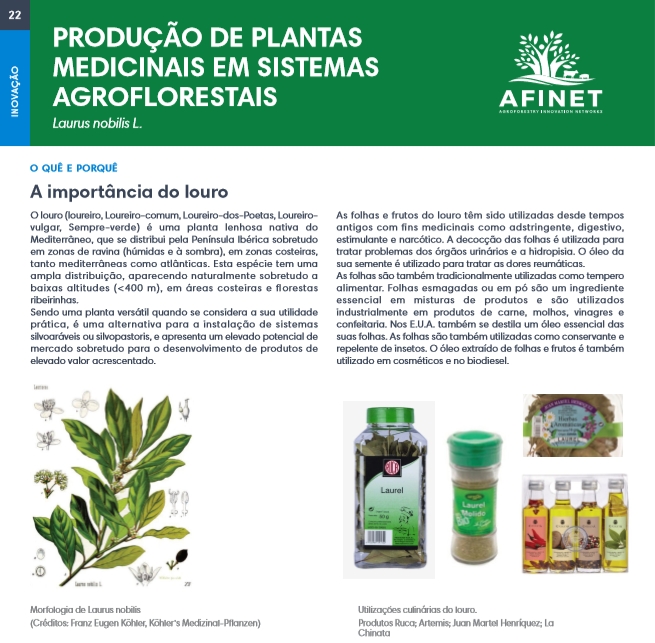 |
22 Produção de plantas medicinais em sistemas agroflorestais O louro (loureiro, loureiro-comum) é uma planta lenhosa nativa do Mediterrâneo, que se distribui pela Península Ibérica sobretudo em zonas de ravina (húmidas e à sombra), em zonas costeiras, tanto mediterrâneas como atlânticas. Esta espécie tem uma ampla distribuição, aparecendo naturalmente sobretudo a baixas altitudes ( |
|
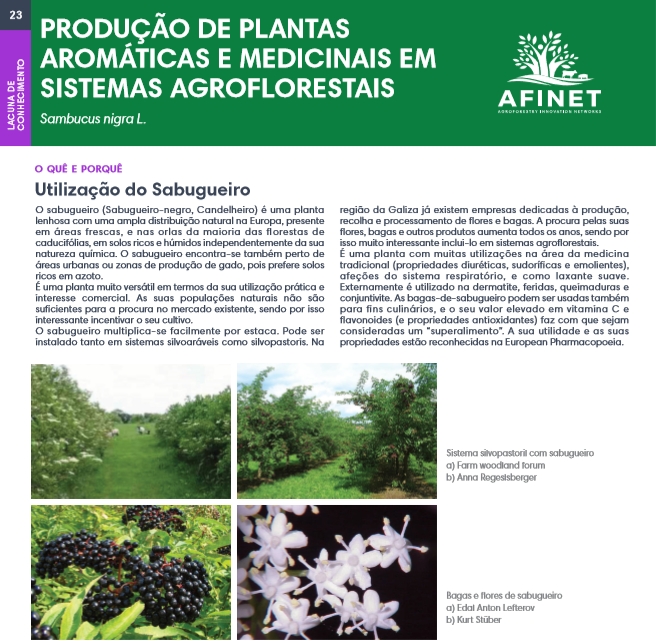 |
23 Produção de plantas aromáticas e medicinais em sistemas agroflorestais O sabugueiro (Sabugueiro-negro, Candelheiro) é uma planta lenhosa com uma ampla distribuição natural na Europa, presente em áreas frescas, e nas orlas da maioria das florestas de caducifólias, em solos ricos e húmidos independentemente da sua natureza química. O sabugueiro encontra-se também perto de áreas urbanas ou zonas de produção de gado, pois prefere solos ricos em azoto |
|
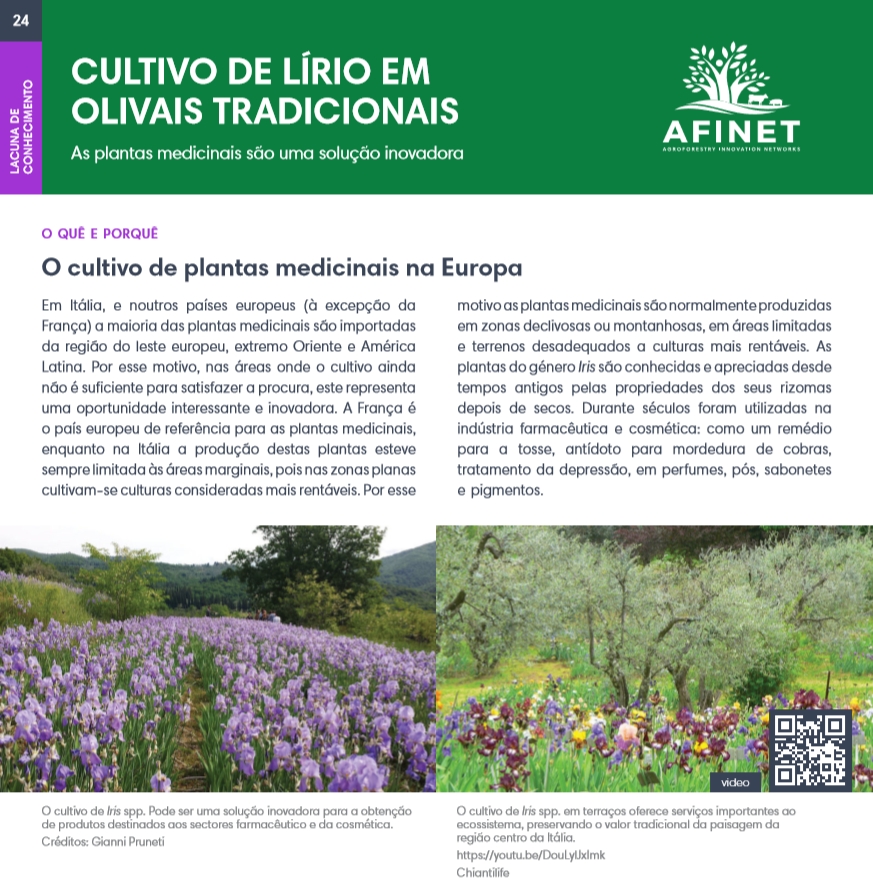 |
24 Cultivo de lírio em olivais tradicionais Em Itália, e noutros países europeus (à excepção da França) a maioria das plantas medicinais são importadas da região do leste europeu, extremo Oriente e América Latina. Por esse motivo, nas áreas onde o cultivo ainda não é suficiente para satisfazer a procura, este representa uma oportunidade interessante e inovadora. A França é o país europeu de referência para as plantas medicinais, enquanto na Itália a produção destas plantas esteve sempre limitada às áreas marginais, pois nas zonas planas cultivam-se culturas consideradas mais rentáveis. |
|
 |
25 Vinhas associadas a árvores que funcionam com tutores vivos Em Itália e Portugal, assim como noutros países europeus, existem vários exemplos de práticas agroflorestais que são utilizadas tradicionalmente. A sua ocorrência era frequente em muitas áreas rurais até à introdução de práticas de agricultura intensiva. |
|
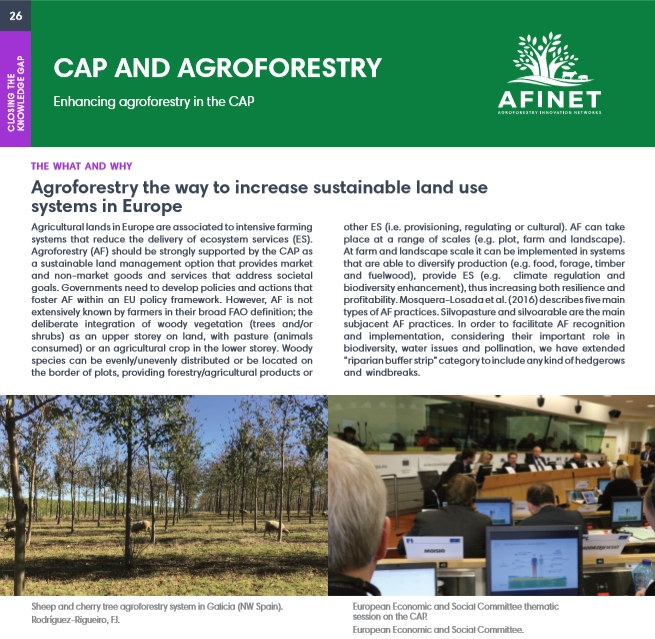 |
Agricultural lands in Europe are associated to intensive farming systems that reduce the delivery of ecosystem services (ES). Agroforestry (AF) should be strongly supported by the CAP as a sustainable land management option that provides market and non-market goods and services that address societal goals. Governments need to develop policies and actions that foster AF within an EU policy framework. Download the high resolution print version (available soon) |
|
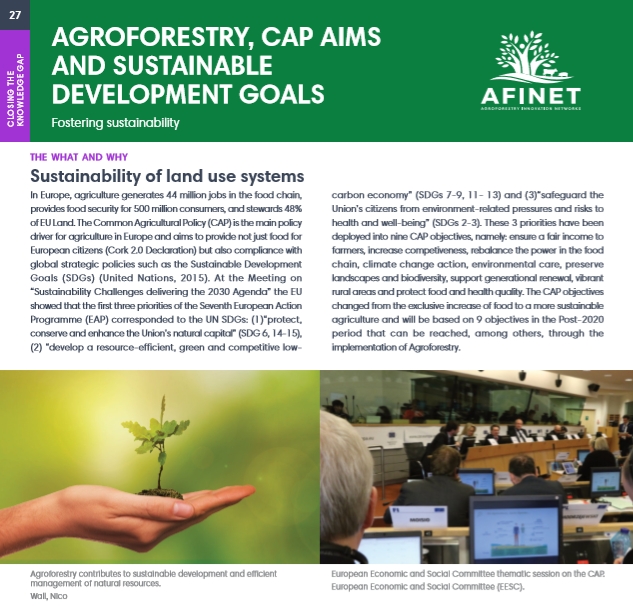 |
27 Agroforestry, CAP aims and sustainable development goals In Europe, agriculture generates 44 million jobs in the food chain, provides food security for 500 million consumers, and stewards 48% of EU Land. The Common Agricultural Policy (CAP) is the main policy driver for agriculture in Europe and aims to provide not just food for European citizens (Cork 2.0 Declaration) but also compliance with global strategic policies such as the Sustainable Development Goals (SDGs) (United Nations, 2015). Download the high resolution print version (available soon) |
|
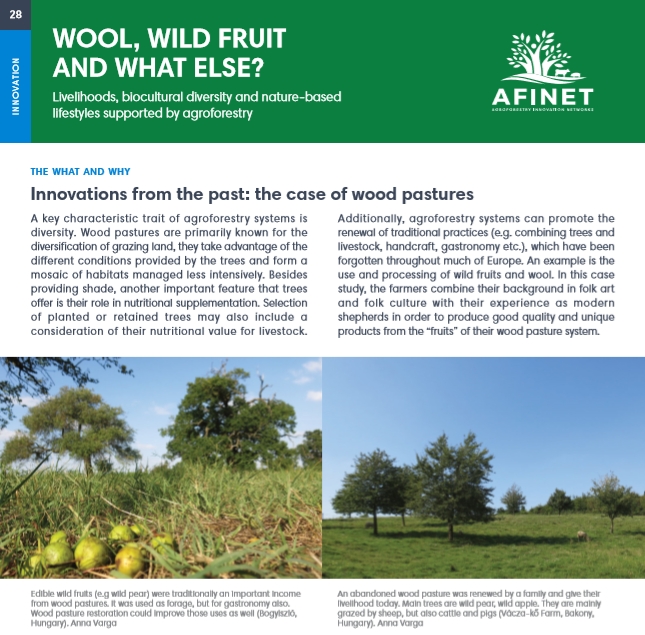 |
28 Wool, wild fruit and what else? A key characteristic trait of agroforestry systems is diversity. Wood pastures are primarily known for the diversification of grazing land, they take advantage of the different conditions provided by the trees and form a mosaic of habitats managed less intensively. Besides providing shade, another important feature that trees offer is their role in nutritional supplementation. |
|
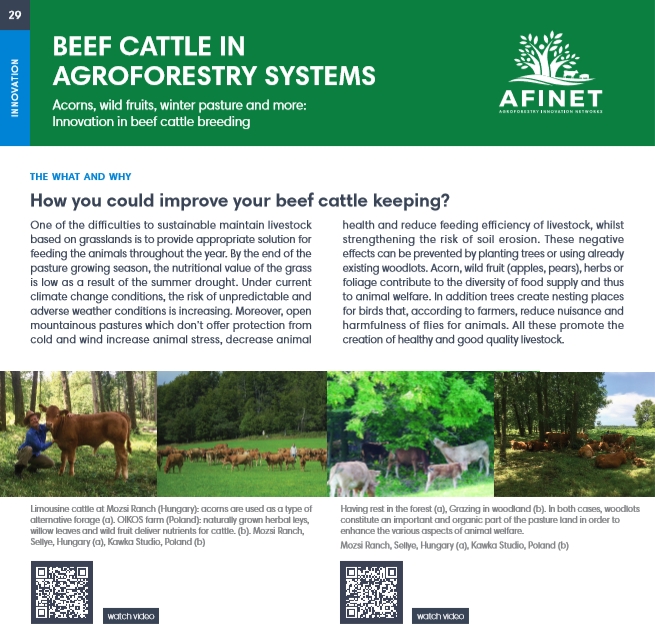 |
29 Beef cattle in agroforestry systems One of the difficulties to sustainable maintain livestock based on grasslands is to provide appropriate solution for feeding the animals throughout the year. By the end of the pasture growing season, the nutritional value of the grass is low as a result of the summer drought. Under current climate change conditions, the risk of unpredictable and adverse weather conditions is increasing. |
|
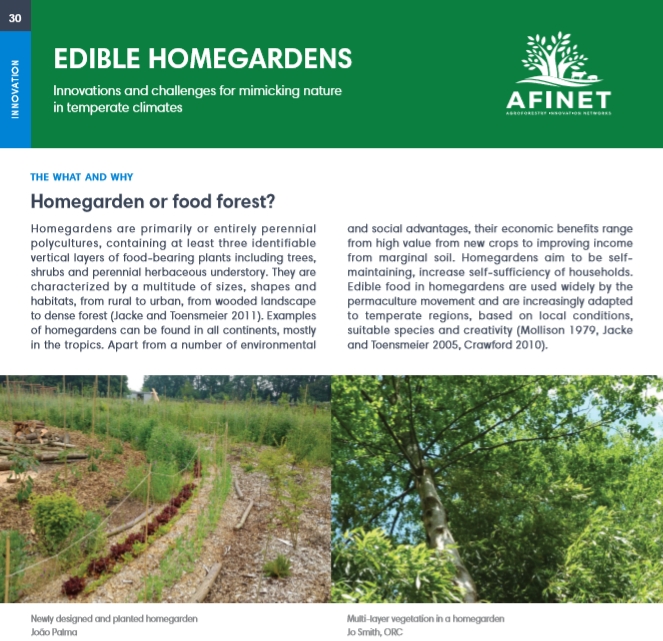 |
Homegardens are primarily or entirely perennial polycultures, containing at least three identifiable vertical layers of food-bearing plants including trees, shrubs and perennial herbaceous understory. They are characterized by a multitude of sizes, shapes and habitats, from rural to urban, from wooded landscape to dense forest (Jacke and Toensmeier 2011). Download the high resolution print version (available soon) |
|
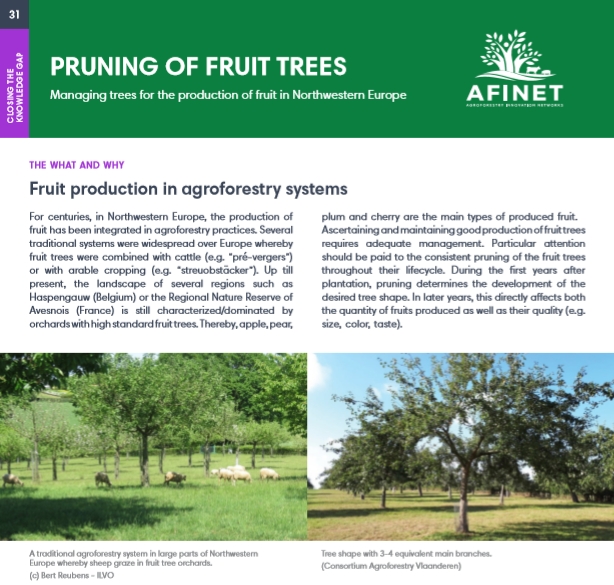 |
For centuries, in Northwestern Europe, the production of fruit has been integrated in agroforestry practices. Several traditional systems were widespread over Europe whereby fruit trees were combined with cattle (e.g. “pré-vergers”) or with arable cropping (e.g. “streuobstäcker”). Download the high resolution print version (available soon) |
|
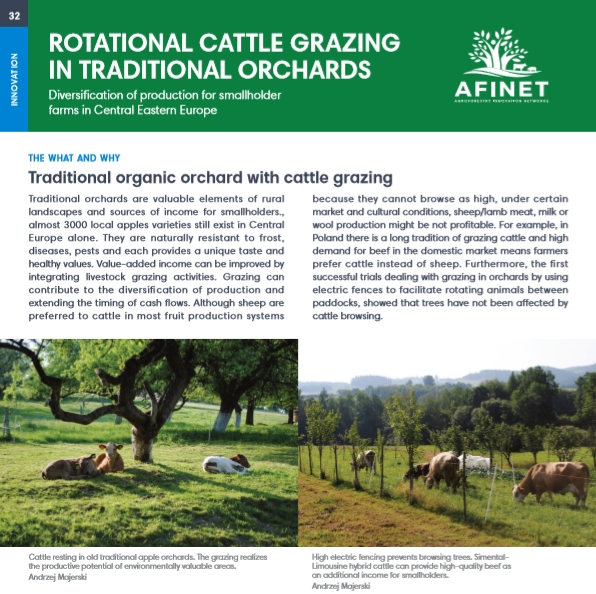 |
32 Rotational cattle grazing in traditional orchards Traditional orchards are valuable elements of rural landscapes and sources of income for smallholders., almost 3000 local apples varieties still exist in Central Europe alone. They are naturally resistant to frost, diseases, pests and each provides a unique taste and healthy values. Value-added income can be improved by integrating livestock grazing activities. Download the high resolution print version (available soon) |
|
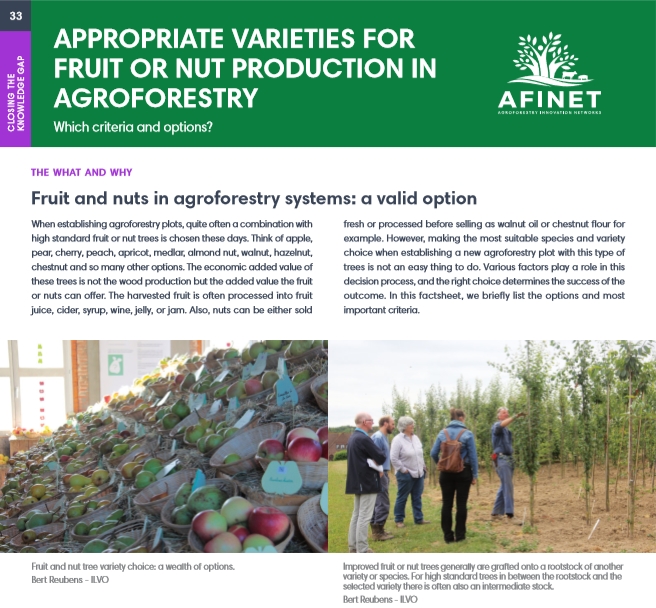 |
33 Appropriate varieties for fruit or nut production in agroforestry When establishing agroforestry plots, quite often a combination with high standard fruit or nut trees is chosen these days. Think of apple, pear, cherry, peach, apricot, medlar, almond nut, walnut, hazelnut, chestnut and so many other options. The economic added value of these trees is not the wood production but the added value the fruit or nuts can offer. Download the high resolution print version (available soon) |
|
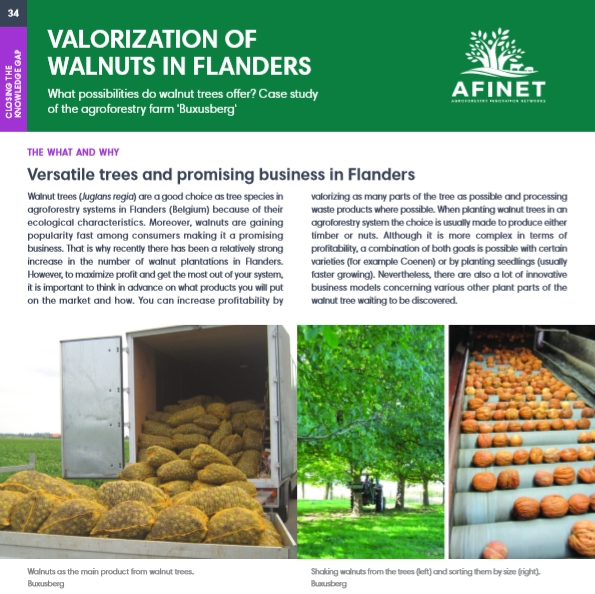 |
34 Valorization of walnuts in Flanders Walnut trees (Juglans regia) are a good choice as tree species in agroforestry systems in Flanders (Belgium) because of their ecological characteristics. Moreover, walnuts are gaining popularity fast among consumers making it a promising business. That is why recently there has been a relatively strong increase in the number of walnut plantations in Flanders. Download the high resolution print version (available soon) |
|
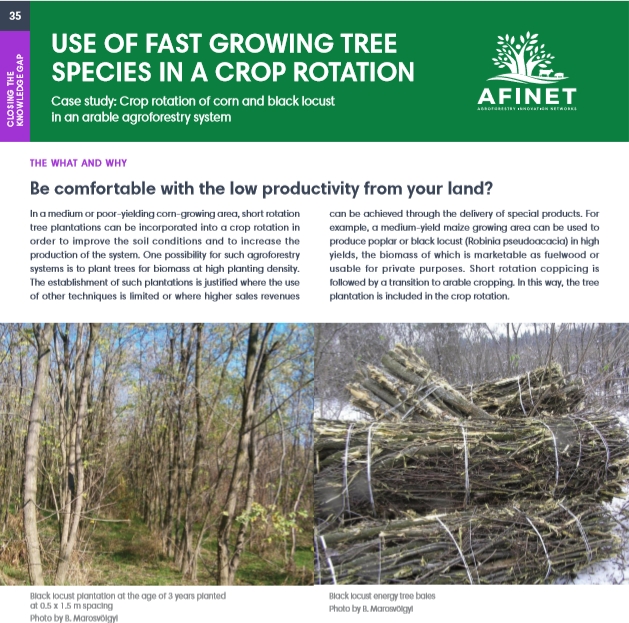 |
35 Use of fast growing tree species in a crop rotation In a medium or poor-yieldingcorn-growing area, short rotation tree plantations can be incorporated into a crop rotation in order to improve the soil conditions and to increase the production of the system. One possibility for such agroforestry systems is to plant trees for biomass at high planting density. |
|
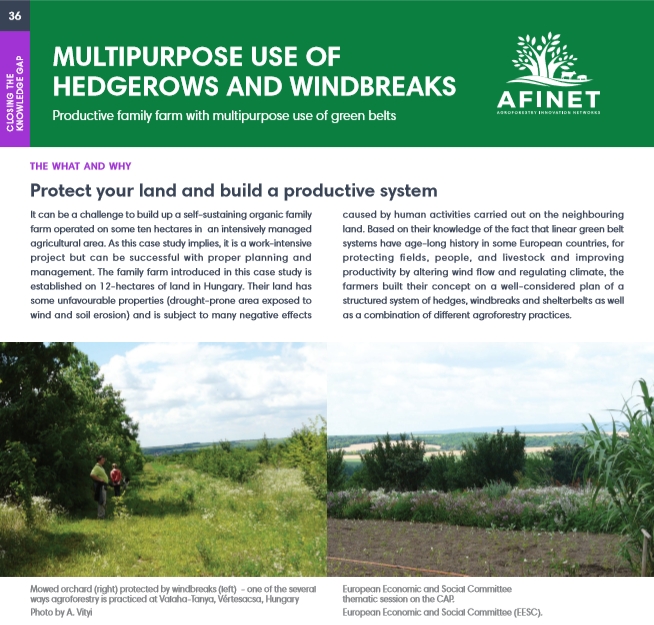 |
36 Multipurpose use of hedgerows and windbreaks It can be a challenge to build up a self-sustaining organic family farm operated on some ten hectares in an intensively managed agricultural area. As this case study implies, it is a work-intensive project but can be successful with proper planning and management. The family farm introduced in this case study is established on 12-hectares of land in Hungary. Download the high resolution print version (available soon) |
|
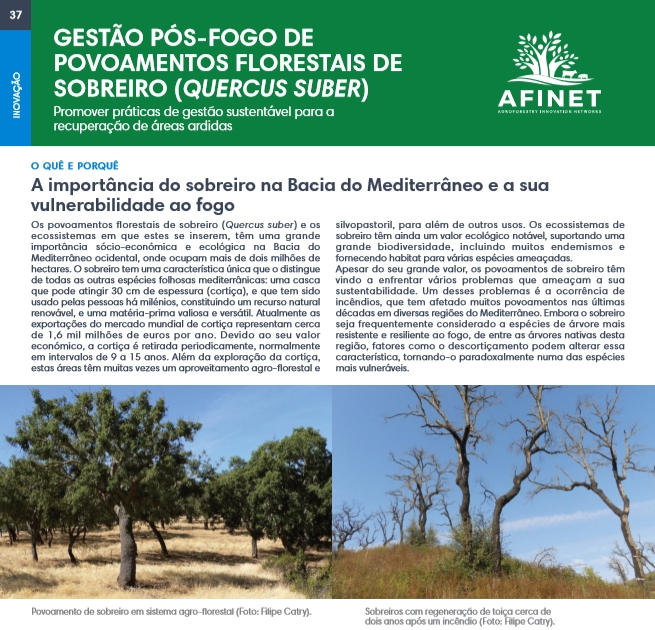 |
37 Gestão pós-fogo de povoamentos florestais de sobreiro (Quercus suber) Os povoamentos florestais de sobreiro (Quercus suber) e os ecossistemas em que estes se inserem, têm uma grande importância sócio-económica e ecológica na Bacia do Mediterrâneo ocidental, onde ocupam mais de dois milhões de hectares. O sobreiro tem uma característica única que o distingue de todas as outras espécies folhosas mediterrânicas: uma casca que pode atingir 30 cm de espessura (cortiça), e que tem sido usado pelas pessoas há milénios, constituindo um recurso natural renovável, e uma matéria-prima valiosa e versátil. |
|
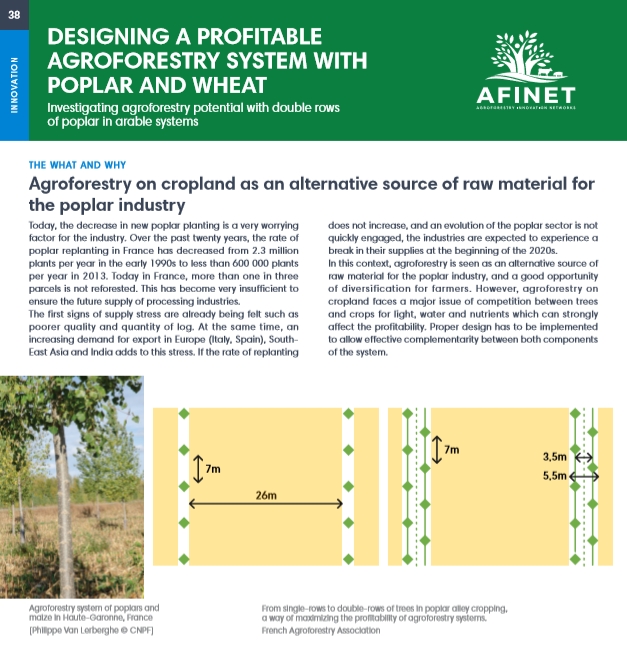 |
38 Designing a profitable agroforestry system with poplar and wheat Today, the decrease in new poplar planting is a very worrying factor for the industry. Over the past twenty years, the rate of poplar replanting in France has decreased from 2.3 million plants per year in the early 1990s to less than 600 000 plants per year in 2013. Today in France, more than one in three parcels is not reforested. This has become very insufficient to ensure the future supply of processing industries. |
|
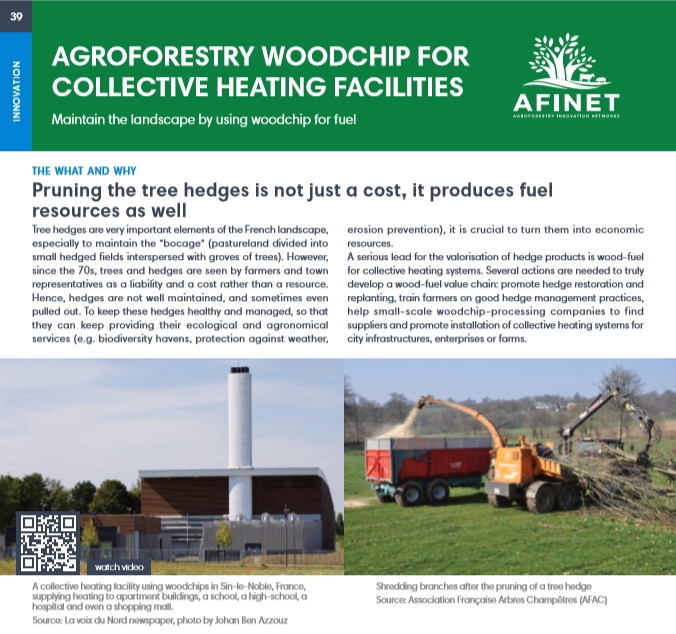 |
39 Agroforestry woodchip for collective heating facilities Tree hedges are very important elements of the French landscape, especially to maintain the “bocage” (pastureland divided into small hedged fields interspersed with groves of trees). However, since the 70s, trees and hedges are seen by farmers and town representatives as a liability and a cost rather than a resource. |
|
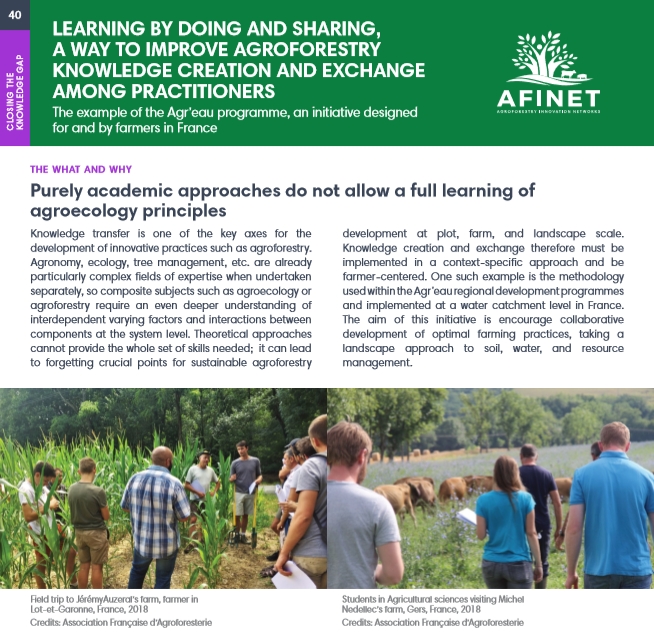 |
Knowledge transfer is one of the key axes for the development of innovative practices such as agroforestry. Agronomy, ecology, tree management, etc. are already particularly complex fields of expertise when undertaken separately, so composite subjects such as agroecology or agroforestry require an even deeper understanding of interdependent varying factors and interactions between components at the system level. |
|
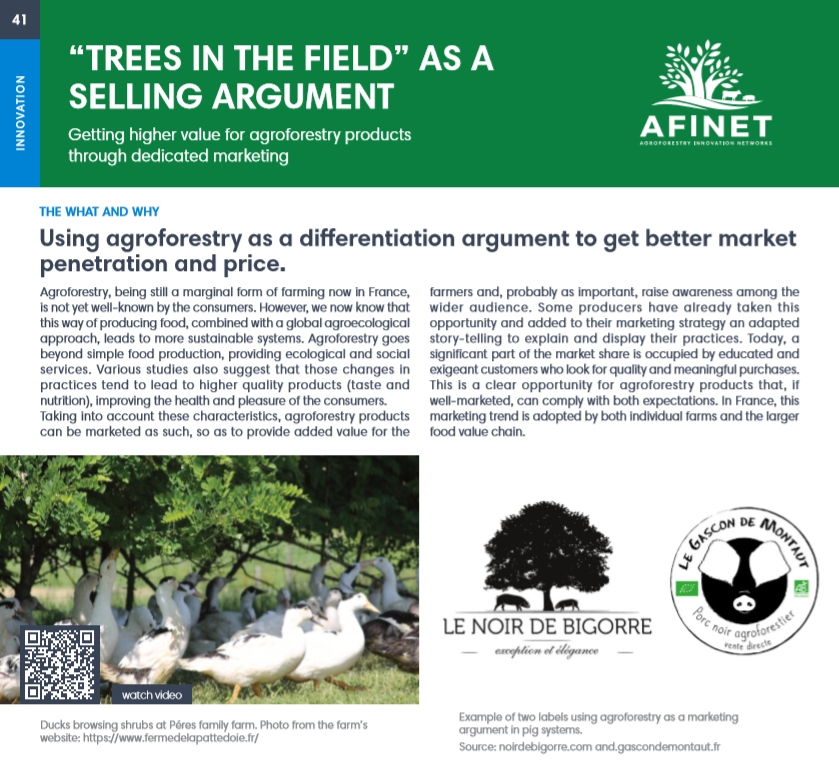 |
41 "Trees in the field" as a selling argument Agroforestry, being still a marginal form of farming now in France, is not yet well-known by the consumers. However, we now know that this way of producing food, combined with a global agroecological approach, leads to more sustainable systems. Agroforestry goes beyond simple food production, providing ecological and social services. |
|
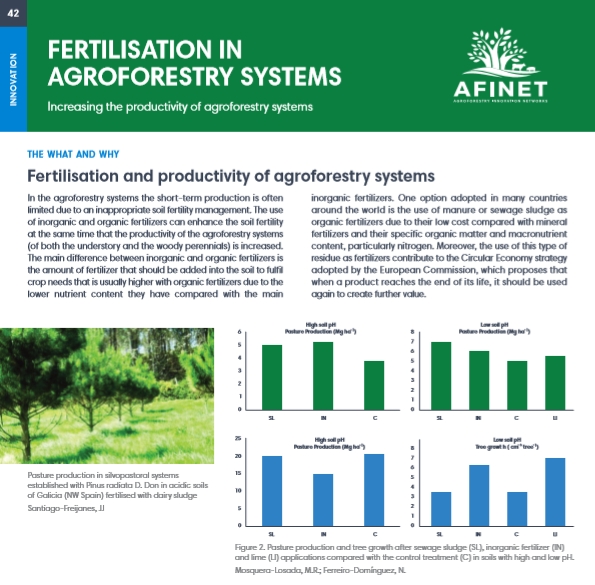 |
42 Fertilisation in agroforestry systems In the agroforestry systems the short-term production is often limited due to an inappropriate soil fertility management. The use of inorganic and organic fertilizers can enhance the soil fertility at the same time that the productivity of the agroforestry systems (of both the understory and the woody perennials) is increased. Download the high resolution print version (available soon) |
|
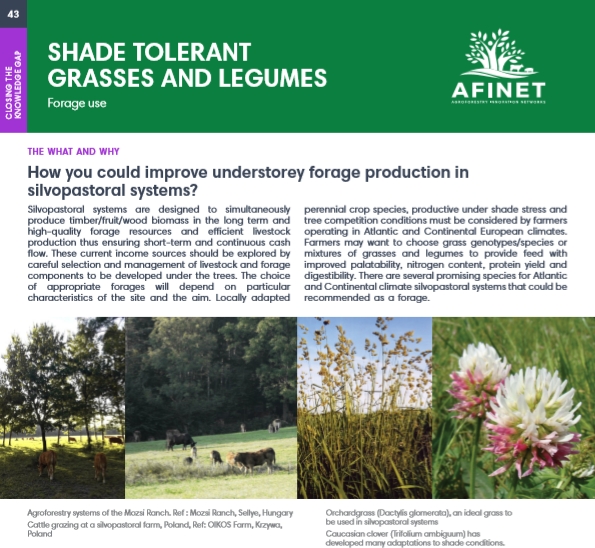 |
43 Shade tolerant grasses and legumes Silvopastoral systems are designed to simultaneously produce timber/fruit/wood biomass in the long term and high-quality forage resources and efficient livestock production thus ensuring short-term and continuous cash flow. Download the high resolution print version (available soon) |
|
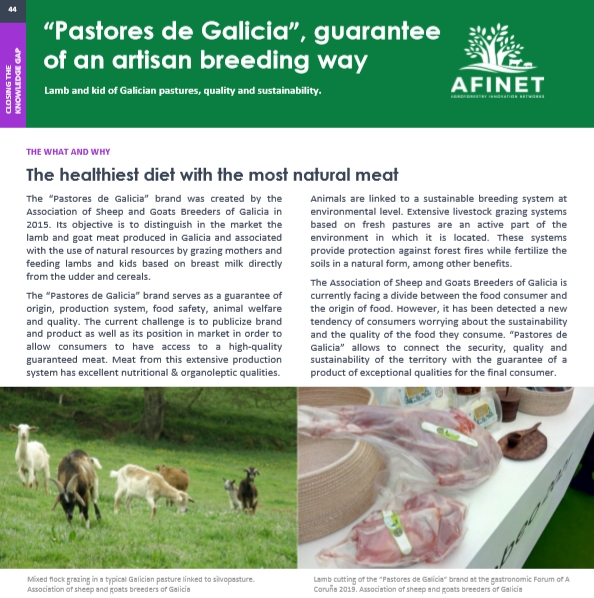 |
44 “Pastores de Galicia”, guarantee of an artisan breeding way The “Pastores de Galicia” brand was created by the Association of Sheep and Goats Breeders of Galicia in 2015. Its objective is to distinguish in the market the lamb and goat meat produced in Galicia and associated with the use of natural resources by grazing mothers and feeding lambs and kids based on breast milk directly from the udder and cereals.
Download the high resolution print version (available soon) |
|
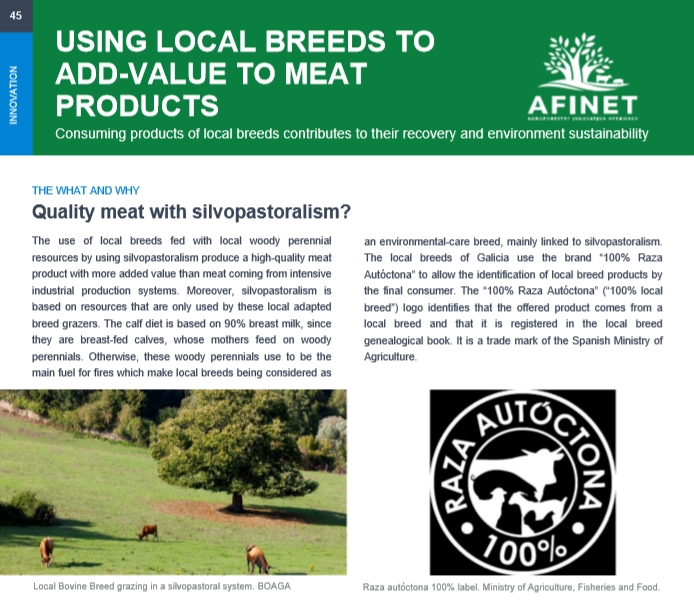 |
45 Using local breeds to add-value to meat products The use of local breeds fed with local woody perennial resources by using silvopastoralism produce a high-quality meat product with more added value than meat coming from intensive industrial production systems. Moreover, silvopastoralism is based on resources that are only used by these local adapted breed grazers. The calf diet is based on 90% breast milk, since they are breast-fed calves, whose mothers feed on woody perennials.
Download the high resolution print version (available soon) |











